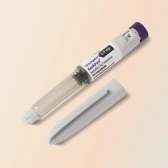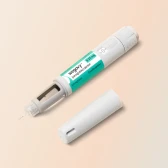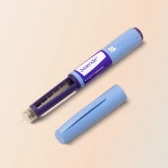If you’ve lost a lot of weight, you might notice that your skin is sitting a little looser in some places. That’s totally normal—after all, your body has shrunk in size and there’s less area for your skin to cover.
Excess skin doesn’t usually cause health problems so if it doesn’t bother you, you don’t necessarily need to do anything about it. Though for some people, it can be disheartening and bring on feelings of self-consciousness.
We get it, trust us. But it’s so important not to lose sight of what you’ve achieved. You’ve come a long way in your weight-loss journey, and that’s worth celebrating.
We also want to remind you that you aren’t alone: loose skin following weight loss is a common concern that we hear a lot at Voy. And there are some solutions that might help to tighten skin and reduce the appearance of sagging.
Read on to learn more about them.
What causes loose skin after weight loss?
Your skin is naturally elastic, and when you gain weight, it stretches. The proteins collagen and elastin give your skin this ability.
Here, you could think of your skin like a rubber band. When it expands, the band is pulled. But if it’s stretched too much over a long enough period of time, it won’t be able to spring back to its original shape. And this can result in some excess skin after weight loss.
How much loose skin you have is influenced by the amount of weight you lost and how long you were at your starting weight (this determines how long the “rubber band” was stretched out for). It’s also thought that how quickly you lose weight plays a role.
Environmental and lifestyle factors can play a role too. Sun damage, smoking, not having a healthy diet and drinking too much alcohol can all contribute to your skin looking saggier. Plus, our levels of both collagen and elastin naturally decline as we get older.
How long does it take for skin to tighten after weight loss?
This is a tough one, because everyone is different. The factors we’ve just explained all influence your skin’s elasticity.
But it’s thought that if you lose weight gradually, this gives your skin time to react to the change and reshape itself over the smaller area.
On the other hand, if you lose a lot quickly, for example via bariatric surgery, your skin doesn’t have time to adjust—so you may be left with more excess skin. If there’s a lot of loose skin, it won’t go away on its own. But there are medical treatments that can help.
These more severe cases tend to affect people who have lost a lot of weight—we’re talking more than 45kg or at least half of their starting weight.
Common areas prone to loose skin
Typically, people notice loose skin on their stomach, breasts, armpit, bottom, upper arms, and thighs. Though it can also affect the face and neck, back, forearms, or calves.
How to get rid of loose skin after weight loss
Before we get into this bit, we want to remind you that there’s nothing inherently wrong with having loose skin after weight loss. It’s only a problem if it’s bothering you or causing worry. But if that’s the case, there are some things which might help.
Gradual, manageable weight loss
As we explained earlier, losing weight gradually is believed to give your skin time to reshape over your new, smaller size—meaning that it’s less likely to sag.
Weight loss medications, like Wegovy or Mounjaro, can be a good option here. They can drive progressive weight loss over at least a year. For example, when following a Wegovy weight loss programme, the amount lost gradually cumulates each month until results eventually plateau.
That’s what happens with Mounjaro as well, though people on this medicine tend to lose more weight than those on Wegovy.
There’s also Saxenda injections, which lead most people to lose at least 5% of their body weight after taking them for over a year.
Strength training
This can help to build up your muscles while maintaining fat loss, which might reduce the appearance of loose skin. Plus, strength training has a bunch of benefits for your body, and some of them may lead to improved skin elasticity and thickness, too. It’s recommended that you do at least two strength training sessions per week for your general health and fitness.
Collagen supplements
Could taking collagen supplements help tighten up your skin? Maybe.
There are studies showing that taking collagen supplements can improve skin elasticity and thickness. But different studies often look at different types of collagen (for example, from fish or pigs, etc.) that are also mixed with other ingredients. So we can’t say for sure whether those benefits are due to collagen or something else.
Also, these studies weren’t specifically looking at people with excess skin after weight loss, so we can’t say if, or to what extent, it might have an impact.
Medical treatments
The main option here is excess skin removal surgery, aka body-contouring surgery. It might be best for people who have more severe sagging, like having skin folds that hang. Your doctor will advise whether this is the right route for you.
But for more minor cases, there’s also radiofrequency-based devices. These work by using heat to stimulate the growth of collagen, and some studies show they can improve skin elasticity.
Science-backed, sustainable weight loss
It’s true that losing a lot of weight can result in loose, excess skin. But please, please don’t let that put you off from reaching for your health goals.
There are so many benefits to achieving a healthy weight: improved heart health, more energy, better sleep, and more. And if you commit to a long-term programme designed to make you lose weight gradually, you may be less likely to experience skin sagging.
In our weight loss programme, you’ll get access to medication plus one-to-one coaching from our team of experts. Medication might be a good choice for you if you’ve tried to lose weight another way but it hasn’t worked as well as you’d liked.
You can take your next step right now. Fill out this short form to see if you’re eligible for our programme.











